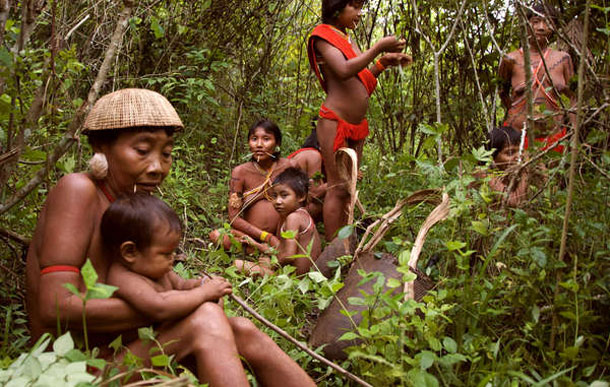
As more companies seek to offset their emissions through forests, indigenous rights must be at the top of the agenda, campaigners say in Glasgow
By Alister Doyle
GLASGOW – (Thomson Reuters Foundation) – Billions of dollars of investments in tropical forests promised at the Glasgow U.N. climate conference should help underpin the rights of indigenous peoples, not just help companies cut greenhouse gas emissions, carbon market experts said on Wednesday.
“A lot of the discussion has focused on what (carbon trading) can do for large corporates in the Western world,”, said Adriaan Korthuis, co-founder of the Climate Focus think-tank in Rotterdam.
A rising drumbeat of companies have signed voluntary net-zero emissions pledges, which they now need to fulfill by slashing their own emissions or buying offsets elsewhere – often through forest projects.
That is expected to lead to a surge in demand for nature-related offsets.
But “indigenous peoples and local communities … so far their position, their rights, their interests have been mainly overlooked,” Korthuis told a forestry seminar at the COP26 U.N. climate conference in Glasgow, via video link.
On Wednesday, banks, insurers and investors with $130 trillion at their disposal pledged to put limiting climate change at the centre of their work.
Earlier, on Monday, more than 100 global leaders promised to halt and reverse deforestation and land degradation by 2030, underpinned by $19 billion in public and private funds to invest in protecting and restoring forests.
“The announcements are fantastic,” said Naomi Swickard of Verra, which helps set standards for certifying carbon credits.
Still, she said, the planned $19 billion was “nowhere near enough” to tap the full power of nature to help solve climate change.
LACK OF OVERSIGHT
Data from Forest Trends’ Ecosystem Marketplace, which tracks fast-expanding carbon trading linked to nature, said the average price paid for a tonne of carbon dioxide absorbed in 2020 was a low $2.51.
So far in 2021, 54% more offsets have been issued than in 2020, according to the data.
But carbon trading and forest experts at COP26 said host governments are doing too little to oversee transactions in expanding voluntary carbon markets (VCM).
“Most governments don’t know what is going on in VCMs in their countries,” Korthuis said, urging them to start by creating a database of projects before turning to tougher issues including how to do fair and accurate carbon accounting.
“The hot potato is how you compare emission reductions” claimed through voluntary carbon markets and those in formal carbon markets run throgh governments, he said.
“We really don’t know how these two systems can be compared.”
Talks are under way at the two-week Glasgow conference to work out rules to govern carbon markets – one of the the final pieces of a rule book to govern the Paris Agreement.
Rules for carbon markets could in turn help expand and drive confidence in voluntary markets.
A Taskforce for Scaling Voluntary Carbon Markets, overseen by former Bank of England chief Mark Carney, is seeking to help lay down rules.
Some environmental groups object to the expansion of carbon markets, saying companies and countries should focus on cutting their own emissions, not buying up credits to offset emissions by preserving or planting forests.
“We are hugely, hugely sceptical of this as a solution,” Greenpeace climate campaigner Charlie Kronick said.
The best way to limit the average rise in global temperatures to the Paris Agreement’s higher-ambition 1.5-degree Celsius cap “is through emissions reductions. It cannot be done by offsets,” he said.
Investing in protecting forests and other “nature-based solution” to climate change through voluntary carbon markets “can help bridge the gap” when investors must cut more carbon than they are able to in their operations, said Annie Groth, an analyst at Biofilica, a Brazilian carbon credit company.
“But it is not a silver bullet,” she said.
She said voluntary carbon markets were often mis-characterised “as a cop-out by governments and corporations not taking action” of their own to cut emissions.
FAILED EFFORTS
Damian Fleming of environmental group WWF said that there have been many largely failed efforts to halt still accelerating forest losses around the world, particularly in key tropical forest nations.
Those include the 2014 New York Declaration on Forests (NYDF), the United Nations sustainability goals and many targets set by global household brands.
New efforts launched at COP26 to protect forests, however, should give “cause for cautious optimism” because of the wide backing of governments and promise of billions of dollars.
But, “the goals of the Paris Agreement are impossible without giving effective participation to indigenous peoples and communities,” he added.
Reporting by Alister Doyle ; editing by Laurie Goering : (Please credit the Thomson Reuters Foundation.






